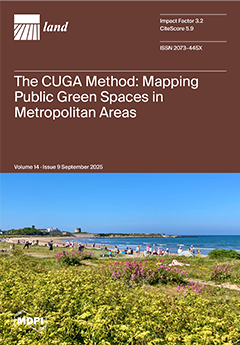This study evaluated soil–atmosphere greenhouse gas (GHG) fluxes—including carbon dioxide (CO
2), methane (CH
4), and nitrous oxide (N
2O)—in cacao agroecosystems on São Tomé Island, Central Africa. The field campaign was conducted between April and May 2025, coinciding with
[...] Read more.
This study evaluated soil–atmosphere greenhouse gas (GHG) fluxes—including carbon dioxide (CO
2), methane (CH
4), and nitrous oxide (N
2O)—in cacao agroecosystems on São Tomé Island, Central Africa. The field campaign was conducted between April and May 2025, coinciding with the transition from the short rainy season to the onset of the dry period. The sampling design comprised two system types (biodiverse and conventional), two crop development stages (growing and productive), and two climatic zones (wet and dry). Gas fluxes were measured using the static chamber method and analyzed in relation to climatic, topographic, and edaphic variables. CO
2 fluxes were the dominant contributor to total emissions, accounting for approximately 97.4% of the global warming potential (GWP), while CH
4 and N
2O together contributed less than 3%. The highest CO
2 emissions occurred in conventional systems during the growing stage in the wet zone (125.5 ± 11.41 mg C m
−2 h
−1). CH
4 generally acted as a sink, particularly in conventional systems in the dry zone (−12.58 ± 2.35 μg C m
−2 h
−1), although net emissions were detected in biodiverse systems in the wet zone (5.08 ± 1.50 μg C m
−2 h
−1). The highest N
2O fluxes were observed in conventional growing systems (32.28 ± 5.76 μg N m
−2 h
−1). GHG dynamics were mainly regulated by climatic factors—such as air temperature, relative humidity, and precipitation—and by key edaphic properties, including soil pH, soil organic carbon, soil temperature, and clay content. Projected GWP values ranged from 9.05 ± 2.77 to 40.9 ± 6.23 Mg CO
2-eq ha
−1 year
−1, with the highest values recorded in conventional systems in the growing stage. Overall, our findings underscore the potential of biodiversity-based agroforestry as a climate-smart practice to mitigate net GHG emissions in tropical cacao landscapes.
Full article





